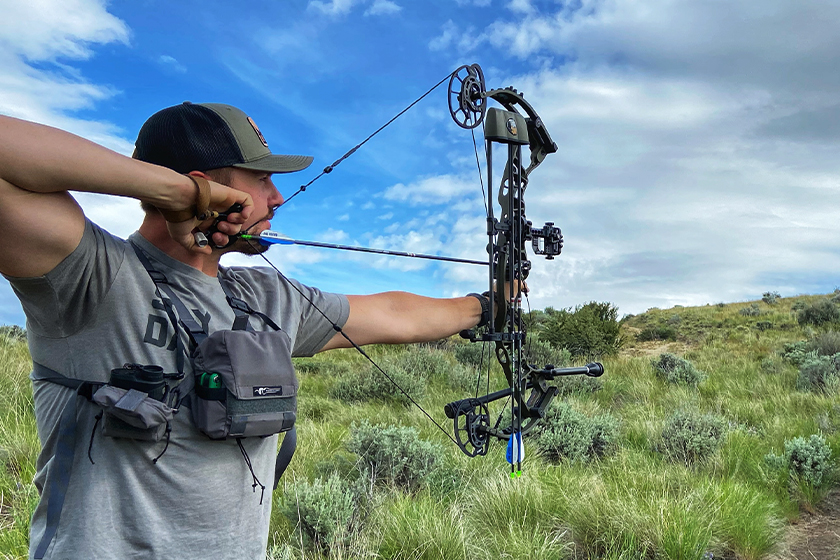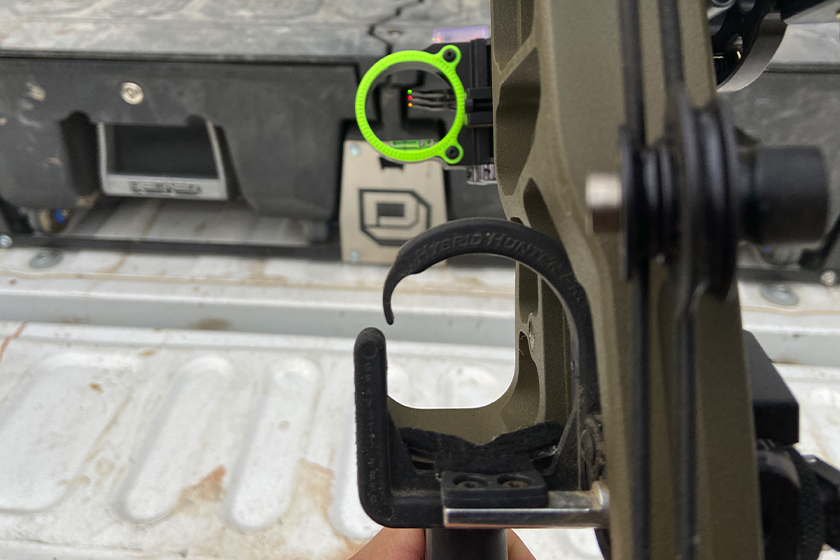
Hoyt’s latest compound bow is designed with the backcountry bowhunter in mind. (Photo courtesy of Joe Ferronato)
Table of Contents
Overview: Hoyt Ventum 33 Bow | $1,249
It’s that time of year again. You know, the time where archery-shop parking lots are chock full, and the pro staff are overwhelmed. The time when hunters realize that the “I have time” sentiment is all but gone and the season is starting in mere days—if it hasn’t started already. Hunters across the country will soon be taking to the hills in pursuit of bull elk or velvet mule deer.
I worked as pro staff in an archery shop for several years while in college and if one thing always held true, it was that people procrastinate when getting their equipment ready for hunting season. Bow sales would always skyrocket when the calendar read September.
I am not one to encourage this behavior, but I may be as guilty as the rest. This year my new bow setup came just weeks before the season—I did make sure to practice with my previous setup throughout the off-season to stay prepared, but I’m just now getting acquainted with my new choice in compound bows.
Years of staring at top-end bows on the shelf built a desire for me to always have the “best” model for the year. This year, with the delays in outdoor products everywhere in the industry, my insatiable lust for something new brought me down to the wire.
As I searched through catalogs of new bows, I studied their specs and ended up going with the Hoyt Ventum 33. This is Hoyt’s aluminum-riser flagship model for the year, and it earned its place at the top of the line.
The Ventum offers two axle-to-axle lengths: a 30-inch and a 33-inch. Due to my height and monkey-like arms, I chose the 33-inch axle-to-axle model. I have found over the years that a longer axle-to-axle bow decreases string angle at my long draw length and allows me to shoot more confidently and accurately at farther distances.

The Ventum 33 features an ATA speed rating of 334 feet per second, with a 6 3/8-inch brace height that is as forgiving as anyone could ask for. And this sleek backcountry killer weighs in at 4.7 pounds—without accessories.
Hoyt’s Newly Designed Cam System
The updated cam system on the Ventum 33 delivers the ultimate blend of comfort, speed, and tunability to make this a versitle hunting bow. The HBX cams allow for draw-length adjustability from 26 inches to 31 inches by choosing between two modules-one of my favorite things about the design of HBX system.
While many other cams on the market are draw-length adjustable, when you get to the longer draws the draw cycle suffers and the shootability of the bow is diminished. However, with the HBX system, my 31-inch draw shoots the same as someone at a 27-inch draw. As an added bonus, these cams are adjustable between 80- and 85-percent let-off for a more comfortable shooting experience in a hunting situation.
Another thing that makes the Hoyt a great option for backcountry and Western hunters is the draw weight variability. These bows come with limbs that offer max poundage ratings of 40, 50, 60, 65, 70, and even 80 pounds. I chose the 80-pound limbs to get a little more speed out of a heavier arrow—and let’s just say it has worked well.
Riser and Stabilizer Redesign
The new riser design features two “integrate” options to ensure the best balance you can get out of your archery setup. Hoyt adopted the same rest integration that companies like Mathews have been using for the past couple of years. Using a dovetail design the QAD Integrate MX will attach directly to the riser in a center-mounted position. In a similar fashion, Hoyt designed the riser to accept a picatinny rail on the front to mount your sight directly in line with the riser. These features can help center-balance your bow by removing a lot of attachment hardware from the outside of the riser.

The biggest change you’ll notice on the riser of all top-of-the-line Hoyt bows this year is the stabilizer mounting location. These bows come with the In-Line Short Stop 2.25 stabilizer mounted just above the limb pocket instead of right below the grip. This all-new positioning gets you more bang for your buck. A 2.25-inch stabilizer has the same effect on balance as a 6-inch stabilizer mounted in the traditional location. This means you can get better balance with a lot less weight—a perfect solution for a dedicated hunting bow. With the addition of a sidebar mounted directly to the riser with Hoyt’s sidebar mount, the bow balances beautifully.
Shootability and Performance from Hoyt
When shooting a bow—especially one that is meant for serious hunting out West—I look for several things: Comfortable, smooth, and silent draw; a firm back wall that holds steady; good balance; and a quiet and shock-free shot. The Ventum met all my criteria from the second I picked it up.
The draw cycle is smooth and comfortable. From initiation to the back wall, the cams pull steady and quietly. There are no hard angles that cause a steep drop off or crash into the valley, making it silent and controllable.
The HBX cams are aggressive, and I was pleasantly surprised to find that the bow holds true when at full draw. The bow doesn’t want to jump forward like many other speed bows on the market. Keep your back muscles engaged and hold for as long as you can. Upon release, the hand shock is minimal.

A quiet bow is a good bow, and the Ventum is nothing short of that. I don’t notice any noise that would make me nervous to hunt with. Yes, the loud bows of the past killed a lot of critters, but the quiet technology of these new bows helps tremendously when taking shots on big game animals. Jumping or ducking the string is very real, and the quieter your bow is the more likely you are to connect on your shot.
I didn’t do myself any favors when it comes to a silent shot. Choosing 80-pound limbs for extra speed on the shot only adds to the possible noise a bow can make. My Ventum is pushing a 500-grain arrow at 301 feet per second—an optimum setup for penetration. This is a speed that is difficult to achieve and many bows that push arrows that fast do it with a snappy, loud shot. The Ventum, though, is quiet—even shooting at an indoor range, the noise was minimal. I wish I had a sound level meter, but unfortunately, you’ll have to take my word for it.
Tuning my Ventum was a breeze. With the HBX cams, yoke tuning is a thing of the past. To tune, you need to remove the axle and cam and place small shims to move the cam left or right to correct your center shot. This was an incredibly simple process—at least with the help of some equipment at the local bow shop. Within minutes we had the Ventum shooting perfect bullet holes through paper. Tuning the bow further I noticed it was incredibly easy to get my desired arrow flight—my broadheads are flying true to my field points and I am ready for the archery season. Follow along in the coming months to see how the Ventum performs on my fall hunts.










































